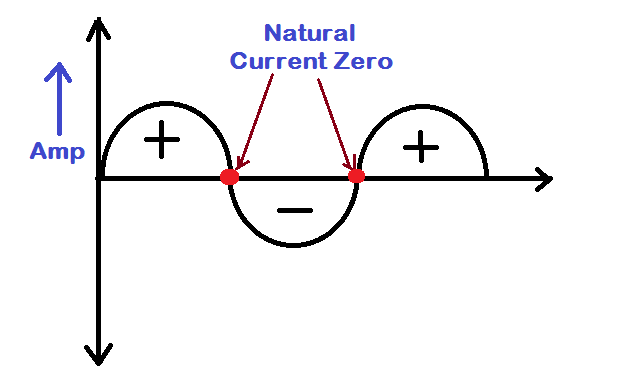Arc Phenomenon
When a short-circuit occurs, a heavy current flow through the contacts of the *circuit breaker before they are opened by the protective system. At that instant when the contacts begin to separate, the contact area decreases rapidly and large fault current causes increased current density and hence a rise in temperature.
[* Important note]:- In single phase circuits (e.g., lighting circuits etc.), a switch is located in only one of the two conductors to lamps. However, in power circuits, a circuit interrupting device (e.g., a circuit breaker) is put in each phase or conductor. These are sometimes called three-pole circuit breakers. In the discussion that follows, we shall confine ourselves to a single-pole device, it is being understood that three such units will be provided in three-phase installation.
The heat produced in the medium between contacts (usually the medium is oil or air) is sufficient to ionize the air or vapourised and ionize the oil. The ionized air or vapour acts as a conductor and an arc is struck between the contacts. The p.d. between the contacts is quite small and is just sufficient to maintain the arc. The arc provides a low resistance path and consequently, the current in the circuit remains flowing so long as the arc persists.
During the arcing period, the current flowing between the contacts depends upon the arc resistance. The greater the arc resistance, the smaller the current that flows between the contacts.
The arc resistance depends upon the following factors:
- Degree of ionization— the arc resistance increases with the decrease in the number of ionized particles between the contacts.
- Length of the arc— the arc resistance increases with the length of the arc i.e., separation of contacts.
- Cross-section of arc— the arc resistance increases with the decrease in the area of the cross-section of the arc.
Principles of Arc Extinction
Before discussing the methods of arc extinction, it is necessary to examine the factors responsible for the maintenance of arc between the contacts. These are:
- The potential difference between the contacts
- Ionized particles between contacts
Taking these in turn, let’s see a short elaboration below:
- When the contacts have a small separation, the p.d. between them is sufficient to maintain the arc. One way to extinguish the arc is to separate the contacts to such a distance that p.d. becomes inadequate to maintain the arc. However, this method is impracticable in a high voltage system where separation of many meters may be required.
- The ionized particles between the contacts tend to maintain the arc. If the arc path is deionized, the arc extinction will be facilitated. This may be achieved by cooling the arc or by bodily removing the ionized particles from the space between the contacts.
Methods of Arc Extinction
There are two methods of extinguishing the arc in circuit breakers viz. High resistance method. & Low resistance or current zero methods.
1. High resistance method.
In this method, arc resistance is made to increase with time so that the current is reduced to a value insufficient to maintain the arc. Consequently, the current is interrupted or the arc is extinguished.
The principal disadvantage of this method is that enormous energy is dissipated in the arc. Therefore, it is employed only in d.c. circuit breakers and low-capacity a.c. circuit breakers.
The resistance of the arc may be increased by :
(i) Lengthening the arc: – The resistance of the arc is directly proportional to its length. The length of the arc can be increased by increasing the gap between contacts.
(ii) Cooling the arc: – Cooling helps in the deionization of the medium between the contacts. This increases the arc resistance. Efficient cooling may be obtained by a gas blast directed along the arc.
(iii) Reducing X-section of the arc: – If the area of cross-section of the arc is reduced, the voltage necessary to maintain the arc is increased. In other words, the resistance of the arc path is increased. The cross-section of the arc can be reduced by letting the arc pass through a narrow opening or by having a smaller area of contact.
(iv) Splitting the arc: – The resistance of the arc can be increased by splitting the arc into a number of smaller arcs in series. Each one of these arcs experiences the effect of lengthening and cooling. The arc may be split by introducing some conducting plates between the contacts.
2. Low resistance or Current zero method.

This method is employed for arc extinction in a.c. circuits only.
In this method, arc resistance is kept low until the current is zero where the arc extinguishes naturally and is prevented from restriking in spite of the rising voltage across the contacts. All modern high power a.c. circuit breakers employ this method for arc extinction.
In an a.c. a system, the current drops to zero after every half-cycle. At every current zero, the arc extinguishes for a brief moment. Now the medium between the contacts contains ions and electrons so that it has small dielectric strength and can be easily broken down by the rising contact voltage known as restriking voltage.
If such a breakdown does occur, the arc will persist for another half cycle. If immediately after current zero, the dielectric strength of the medium between contacts is built up more rapidly than the voltage across the contacts, the arc fails to restrike and the current will be interrupted.
The rapid increase of dielectric strength of the medium near current zero can be achieved by :
- (a) causing the ionized particles in the space between contacts to recombine into neutral molecules.
- (b) sweeping the ionized particles away and replacing them with un-ionized particles Therefore, the real problem in a.c. arc interruption is to rapidly deionize the medium between contacts as soon as the current becomes zero so that the rising contact voltage or restriking voltage cannot break down the space between contacts.
The de-ionization of the medium can be achieved by:
- lengthening of the gap: – The dielectric strength of the medium is proportional to the length of the gap between contacts. Therefore, by opening the contacts rapidly, the higher dielectric strength of the medium can be achieved.
- high pressure: – If the pressure in the vicinity of the arc is increased, the density of the particles constituting the discharge also increases. The increased density of particles causes a higher rate of de-ionization and consequently, the dielectric strength of the medium between contacts is increased.
- Cooling: – Natural combination of ionized particles takes place more rapidly if they are allowed to cool. Therefore, the dielectric strength of the medium between the contacts can be increased by cooling the arc.
- blast effect:- If the ionized particles between the contacts are swept away and replaced by unionized particles, the dielectric strength of the medium can be increased considerably. This may be achieved by a gas blast directed along with the discharge or by forcing oil into the contact space.
Reference Book: Principles of power systems vk-mehta











